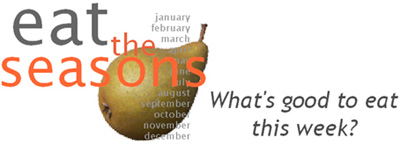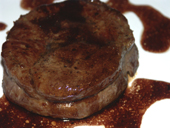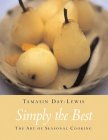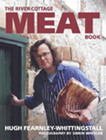
•
UK/Ireland
Canada/USA
________________________________________________________________________

eat
VENISON
Much of the venison
produced in the UK is from deer that roam freely, rather than being intensively
farmed, resulting in superior meat. Good quality venison is tender, tasty
and close textured, which means it's easy to produce great results using
simple recipes such as Medallions of Venison with Red Wine and Juniper
(pictured).
HISTORY
Meat from deer has been important in the human diet since prehistoric times. The term venison (from the Latin venari - to hunt) originally referred to meat from any wild animal.
For centuries, deer parks owned by European aristocrats have been used as a source of sport and high quality food. This concentration of valuable meat with access restricted to the elite few has long been a source of conflict between poacher and gamekeeper.
BIOLOGY
Deer are ruminant animals belonging to the family Cervidae. They are characterised by having antlers, rather than horns, and small, unspecialised stomachs. Instead of grazing on vast quantities of grass, deer tend to select easily digestible shoots, young leaves, fruit, fungi and lichens.
Three species are commonly used for food in Britain: the red deer (largely from the Scottish Highlands); the fallow; and the roe (the smallest and considered the best by many cooks).
NUTRITION
Julie (Nutritional Therapist) writes: venison has higher iron levels than any other red meat, contains omega 3 fats and less fat than a skinned breast of chicken.
TIPS
BUYING
Go for park (free-range) or wild venison over farmed. The strength of
flavour and fat content in venison can vary quite a bit between sources
so buying from a farmers' market or trusted butcher will enable you to
ask what to expect and pick up cooking tips.
STORING
For a few days in the fridge (or longer if vacuum packed).
PREPARING
Cook venison as you would beef. It is best to compensate for the lower
fat content, for example by using moist-cooking methods, by barding or
by marinating before cooking.
Good quality steaks and tenderloin can be pan-fried but try to avoid overcooking. Serving with a sauce is recommended. To maintain maximum succulence, Mrs Beeton (in her Book of Household Management) recommends serving venison on very hot plates as venison fat has a high melting point. This seems like sensible advice as cold venison is certainly much less appetising than, say, cold beef.
Excellent partnering flavours for venison include juniper, gin, red wine, port, rosemary and redcurrant.
OTHER STUFF
In his diaries, Samuel Pepys speaks highly of venison dishes on a number of occasions, including:
At the Clerk’s chamber I met with Simons and Luellin, and went with them to Mr. Mount’s chamber at the Cock Pit, where we had some rare pot venison, and ale to abundance till almost twelve at night, and after a song round we went home.
...and...
Mr. Moore and I and several others being invited to-day by Mr. Goodman, a friend of his, we dined at the Bullhead upon the best venison pasty that ever I eat of in my life, and with one dish more, it was the best dinner I ever was at.
PICK OF THE RECIPES
in
season:
january
february
march
april
may
june
july
august
september
october
november
december
Central London
locale
Pastry, pasta,
puds and lots more!
Fun and deliciously
different
www.cookeryschool.co.uk

A
contract catering
company that puts
quality and freshness first
www.artizian.co.uk
ONLINE
IN PRINT
-
Medallions of Venison with Red Wine and Juniper
Simply the Best -
Venison Jerky
The River Cottage Meat Book -
Pappardelle with Amazing Slow Cooked Meat
Jamie's Kitchen
© 2004-2010 eat the seasons | contact @ eattheseasons.co.uk | about

